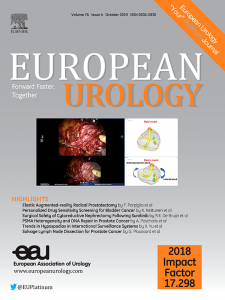Updated Prostate Cancer Risk Groups by Prostate-specific Membrane Antigen Positron Emission Tomography Prostate Cancer Molecular Imaging Standardized Evaluation (PPP2): Results from an International Multicentre Registry Study
IF 25.2
1区 医学
Q1 UROLOGY & NEPHROLOGY
引用次数: 0
Abstract
Background and objective
We established prognostic nomograms incorporating prostate-specific membrane antigen (PSMA) positron emission tomography (PET) parameters standardised by Prostate Cancer Molecular Imaging Standardized Evaluation (PROMISE; PPP1). Here, we develop an updated PPP2 risk score from a large international multicentre registry study.Methods
We included 6128 prostate cancer patients who underwent PSMA-PET at 20 hospitals in Europe, USA, and Australia between 2013 and 2022. Investigator sites were split 2:1 into the development (4044 patients) and validation (2084 patients) cohorts. We created nomograms of version 2 (PPP2) based on Cox regression models with the least absolute shrinkage and selection operator penalty for overall survival (development cohort). Performance of both nomograms was measured using Harrell’s C-index and calibration plots and a head-to-head comparison with the National Comprehensive Cancer Network (NCCN) risk score by receiver operating characteristic curves (validation cohort).Key findings and limitations
Predictors were distant metastases (extrapelvic nodal metastases [M1a], bone metastases [M1b], and visceral metastases [M1c]), PSMA expression score, and total lesion count (visual PPP2) or total tumour volume (quantitative PPP2). C-indices (95% confidence interval) in the validation cohort were 0.80 (0.78–0.82; visual) and 0.80 (0.79–0.82; quantitative), respectively. Accuracy of both the PPP2 nomograms was superior to the NCCN risk score (n = 1034, area under the curve 0.84 vs 0.76; p < 0.001). The retrospective design represents a limitation of the study.Conclusions and clinical implications
PPP nomograms were improved in an international multicentre study to predict accurately the 3- and 5-yr overall survival probabilities of prostate cancer. PPP2 yielded superior accuracy to the NCCN risk score. A free software tool has been created for PROMISE and PPP2 assessments (promise-pet.org).前列腺特异性膜抗原正电子发射断层扫描前列腺癌分子成像标准化评估(PPP2):来自国际多中心注册研究的结果
背景与目的我们建立了前列腺特异性膜抗原(PSMA)正电子发射断层扫描(PET)参数由前列腺癌分子成像标准化评估(PROMISE;PPP1)。在这里,我们从一项大型国际多中心注册研究中开发了一个更新的PPP2风险评分。方法纳入2013年至2022年间在欧洲、美国和澳大利亚20家医院接受PSMA-PET治疗的6128例前列腺癌患者。研究地点按2:1分为发展组(4044例)和验证组(2084例)。我们基于Cox回归模型创建了版本2 (PPP2)的nomogram,该模型具有最小的绝对收缩和选择算子对总生存期(发展队列)的惩罚。使用Harrell的c指数和校准图来测量两种形态图的性能,并通过受试者工作特征曲线(验证队列)与国家综合癌症网络(NCCN)风险评分进行正面比较。预测因子包括远处转移(盆腔外淋巴结转移[M1a]、骨转移[M1b]和内脏转移[M1c])、PSMA表达评分、总病变计数(视觉PPP2)或总肿瘤体积(定量PPP2)。验证队列的c指数(95%置信区间)为0.80 (0.78-0.82;视觉)和0.80 (0.79-0.82;分别定量)。两种PPP2图的准确性均优于NCCN风险评分(n = 1034,曲线下面积0.84 vs 0.76;p & lt;0.001)。回顾性设计是本研究的局限性。结论和临床意义在一项国际多中心研究中,sppp图得到了改进,可以准确预测前列腺癌3年和5年的总生存率。PPP2的准确性优于NCCN风险评分。为PROMISE和PPP2评估创建了一个免费软件工具(promise-pet.org)。
本文章由计算机程序翻译,如有差异,请以英文原文为准。
求助全文
约1分钟内获得全文
求助全文
来源期刊

European urology
医学-泌尿学与肾脏学
CiteScore
43.00
自引率
2.60%
发文量
1753
审稿时长
23 days
期刊介绍:
European Urology is a peer-reviewed journal that publishes original articles and reviews on a broad spectrum of urological issues. Covering topics such as oncology, impotence, infertility, pediatrics, lithiasis and endourology, the journal also highlights recent advances in techniques, instrumentation, surgery, and pediatric urology. This comprehensive approach provides readers with an in-depth guide to international developments in urology.
 求助内容:
求助内容: 应助结果提醒方式:
应助结果提醒方式:


